From: Invergarry to Invermoriston
Distance: 17m / 27.3km
Cumulated distance: 1032m / 1661km
Percentage completed: 87.2
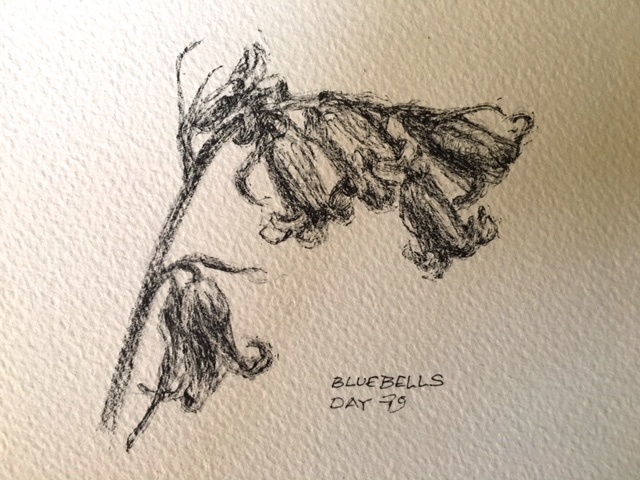
Some of the longer days on this journey have gone on and on, feeling as if they would never finish. Today’s walk of 17 miles should really have been one of those days. But the myriad of conversations we had about our hopes and aspirations, our children and our families, the cosmos and the universe, meant the day sped by at galactic speed. From Invergarry we set off through Nursery Wood until we reached the shore of Loch Oich. It was damp and mossy underfoot and the views across to the ruins of Invergarry Castle were utterly beautiful .. although for some absurd reason there is no photographic record. Too much chatting probably.
After flooding destroyed the old stone bridge over the River Oich in 1849, a new bridge was needed. Enter stage right, an English brewer, James Dredge. Not an obvious choice for the creation of a bridge, you’re thinking. However, Dredge threw in the beer-making and became an engineer in later life. He designed an ingenious double-cantilever bridge. It was light and more stable than its stone predecessor and has clearly stood the test of time .. as have the other 30 bridges that he designed across the UK.

Dredge’s bridge over the River Oich
It was a hop, skip and a jump from Dredge’s bridge to Cullochy Lock, which marked the end of Loch Oich. There were plenty of sea-faring vessels on the Caledonian Canal which demonstrated just how important the waterway has been over the years.

Farewell to Loch Oich
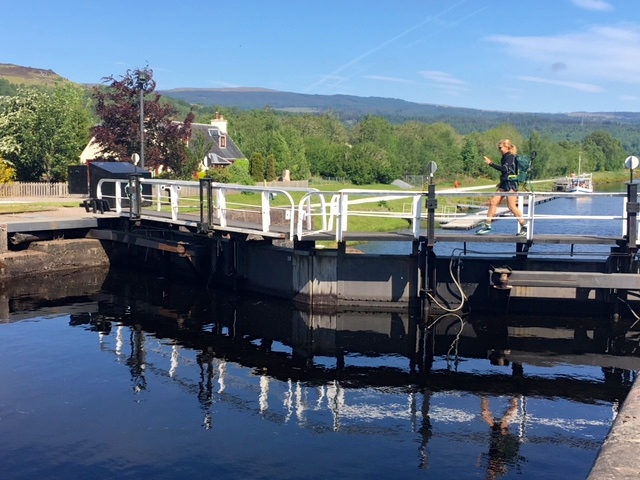
Sophie speeding across Cullochy Lock

Large barges ..
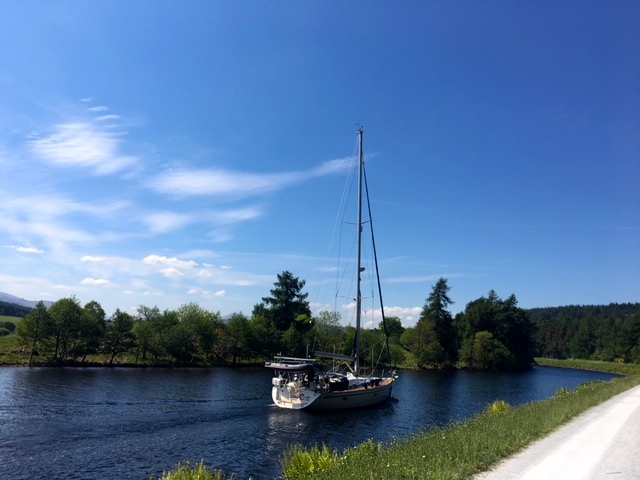
.. and sailboats on the canal ..

.. with lifebuoys at the ready
For a good while the gushing River Oich ran parallel to the Caledonian Canal and we walked between the two on the spit of a towpath. There was a fair amount of traffic on the canal and a group of people in canoes excitedly alerted us to the fact that a littler further on, a herd of red deer were grazing in the meadow. By the time we reached them they were far away but you can just about make them out in my photo!

Herd of red deer
Our next point of interest was Fort Augustus. It’s a little village, built around the canal and locks, with a smattering of facilities, tasteful gift shops and a butcher where you can buy deer antlers. We stopped at one of the cafes for a coffee. It was so good we had a second, after we’d made sure we had the cash to pay for them.

AMEX certainly not accepted
The aromatic St Cumin of Iona created a small settlement here in the 6th century. The Benedictines, many centuries later, built an abbey on a nearby spot, which they only vacated as recently as 1997. Today, the village was a hive of activity with men in kilts playing the pipes and flotillas of boats making their way through the lock.
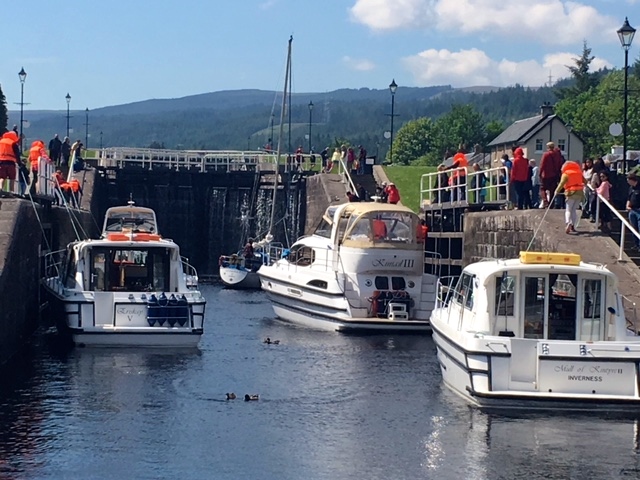
Fort Augustus
Just to the north of Fort Augustus, spanning the river, is the abandoned 18th century Old Oich tressle bridge. In its state of delapidation it looked picturesque, especially with the gulls swooping across in front of it.
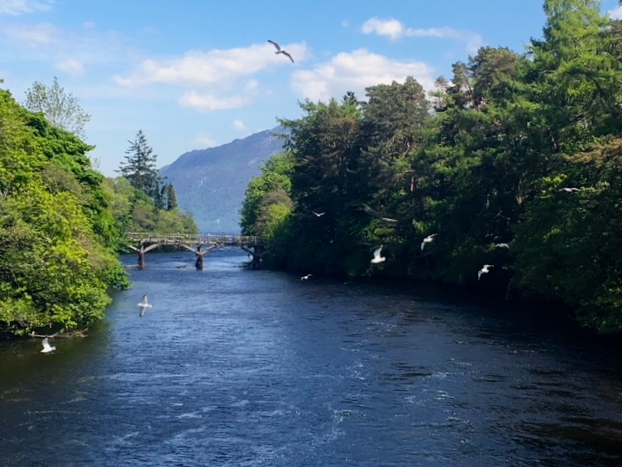
Old Oich Bridge
Fort Augustus lies at the head of Loch Ness, which is a massive 37 kilometres long. Our eyes subconsciously sharpened so that we wouldn’t miss anything that could possibly resemble a ‘monster, so horrible, so terrible’ .… especially as Sophie’s extremely informed taxi driver, the inimitable red-headed Rory, had told her the last sighting had been only two months ago in March. And as became clear, Rory knows just about everything there is to know about things Scottish. Including which part of the loch to jump into at Hogmanay at 4 in the morning.
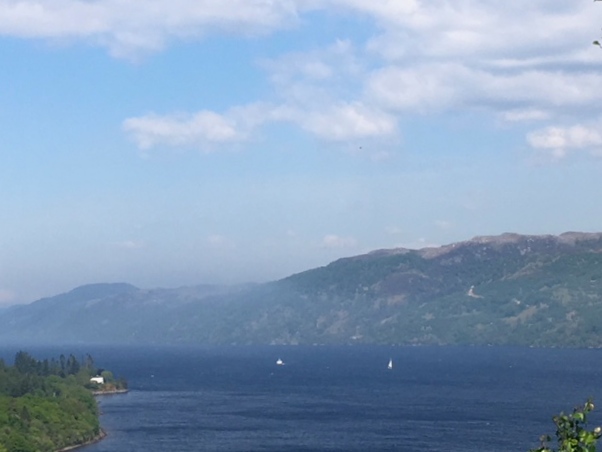
Loch Ness
The scientific world relegates Nessie to folklore, all sightings put down to hoaxes, wishful thinking or the misidentification of a miscellany of inanimate objects. Such a shame! I would so like to have looked out at the loch and have the long neck and head emerge, followed by the two humps on the back of a Scottish beastie. Much has been written about the origin and hoaxes over the years. It’s thought the first sighting was in the 6th century AD when the Irish saint, Columba was able to perform his first miracle by making the sign of the cross and banishing the monster.
All was then quiet for several centuries until Londoner, George Spicer in 1933 reported that he and his wife had seen ‘the nearest approach to a dragon or pre-historic animal that I have ever seen in my life’, trundling across the road. The story made it into the ‘Inverness Courier’ and hot on the heels of the sighting, ‘The Daily Express’ got in on the act. Their story even had an accompanying photo, taken by Mr Hugh Gray. Amazingly, the story was taken so seriously that the Scottish Secretary for State issued orders to the police for them to prevent any possible threats to the beast’s life. The following year the anonymous ‘Surgeon’s photo’ of Nessie further piqued public interest. It must have been a wild time to be alive .. a time when the absence of sophisticated forensic science still allowed the possibility of a monster to be roaming the land.

No sign of Nessie today
It’s been agreed by most since 1994 that the photo was an elaborate prank, born out of revenge. Marmaduke Wetherell had been publicly ridiculed by his employer, the Daily Mail, after he’d reported his finding of ‘Nessie footprints’ and they’d been exposed as a hoax. To make his monster, Wetherell had attached a wooden putty head to a toy submarine bought from Woollies. He photographed the beastie using an out of focus lens and got a third party to sell the photo to the Mail. The newspaper fell for it! Can’t think of a finer recipient to be fooled by such fake news, other than the Donald himself.
There have been countless theories and ‘sightings’ since, although no-one’s ever had their smart phone close enough to record the occasion. My own favourite was the suggestion that a travelling circus might have allowed their elephant to swim in the loch and that photographs of his trunk could have been construed as Nessie’s neck. Hoaxes have been ingenious .. a hippo foot umbrella stand used to make fake footprints, an elephant seal shaved of its whiskers after death and dumped in the loch. And then more recently, the finding of a dead deer on the shore of the loch, with a huge tooth in its side, purporting to be that of the monster .. in actual fact, it was a muntjac antler.
Google even got into the spirit of the search when they commemorated the 81st anniversary of the ‘surgeon’s photograph’ with a Google Doodle and added a ‘new feature to Google Street View, which enables users to explore the loch above and below the water’.
OK, OK. That’s quite enough on the monster. I could very easily have sung to Sophie at the beginning of the day, ‘You’ll take the high road and I’ll take the low road‘ today as there are two parallel routes along Loch Ness. But we figured that if one of us were really to see the monster, then we’d need the other to be the witness, in order to be taken seriously. OK .. truly, that’s enough. Time for a rest ..
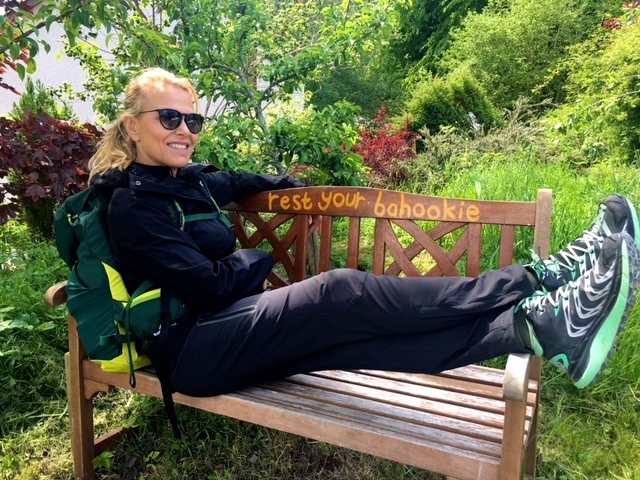
Sophie resting her bahookie ..

.. while I rested my sights on Nessie
The path we took was through woods and forest. There was an abundance of wild flowers which led to nostalgic conversations about our countryside childhoods spent in France and England. We shared the different folklore surrounding the flowers and the games and rhymes we’d used with our friends. As we reminisced we picked a few of the flowers to create a rustic bunch ..
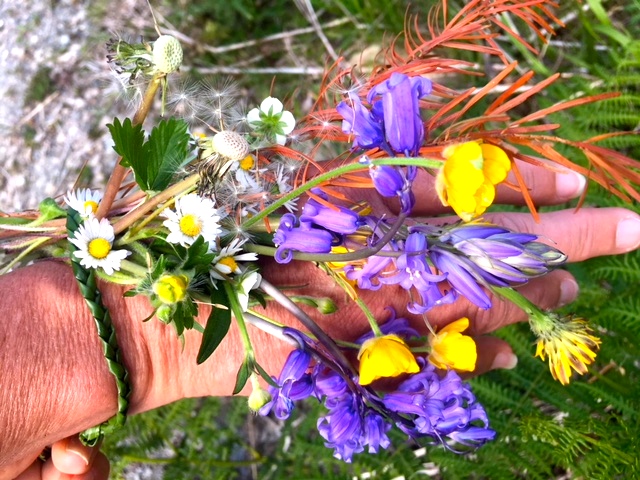
Plaited bracelet of wild flowers
Gentle reader, if you grew up in Europe you’ll remember the heady aroma of bluebells or clochettes; daisies or paquerettes which we plucked to play ‘he loves me .. he loves me not’; buttercups or boutons d’or held under the chin to see if your friend liked butter; the heads of dandelion or pissenlit blown to tell the time and fraises des bois eaten to further sweeten summer days. Divine, simple pleasures.

Butterflies on the forest floor

Magical conifers ..

.. and zephyr-blown birches
Our day ended surprisingly early at the Glenmoriston Arms Hotel. There was plenty of time for drinks and pheasant hotpot before a much anticipated and enjoyed leg massage. All in all, a faultless day.
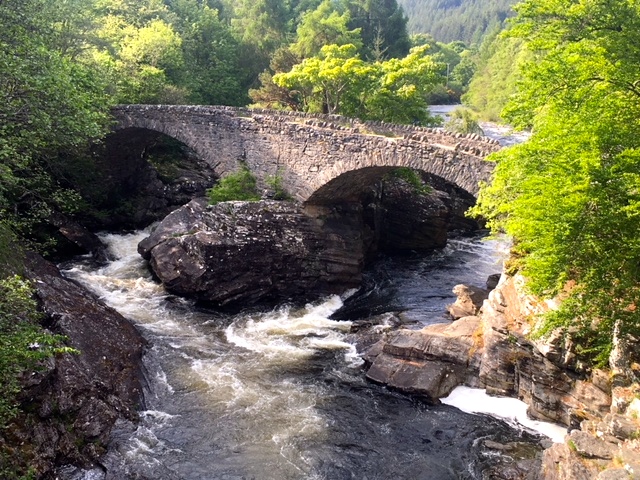
Waterfalls at River Moriston close to the hotel
Black Dog Tails
If only we all got this excited about going to work! Meet DeeDee, a contraband detection dog in Michigan.
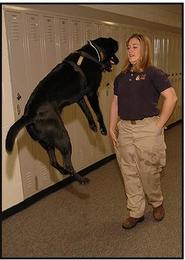
![]()


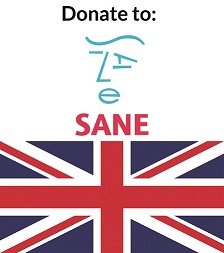
Hi Jules, Your day looks divine. We’ve just had another glorious weekend in the Lake District where the scent of the bluebells filled the air. Heavenly.
Hope your bahookie is fully rested.
Sue
xx
Bahookie doing very well, thanks! How did the house-hunting go? See you in London, soon. x
Gorgeous Jules – your plaited green bracelet and flowers! How special reminiscing your countryside childhood games….. I remember them too. What a special time together
It’s been wonderful having Sophie with me .. such a tower of strength and so much fun. x
The Great Glen looks full of interest with plenty to see. I was trekking through wilder country north of Lairg. At one point I had trouble with my boots, That pair still reside on my hearth as a memento.
Day 72 Thursday 26th June 2008, Crask Inn to Gearnsary bothy (NC 732 321) 16 miles.
“…descending the other side of this pass the sole of my right boot came off from the instep back to the heel. I spent three quarters of an hour making a hole through the edge of the sole and the rubber welt and then inserting a zip tie. I used most of the tools on my Swiss Army Knife. Later I stopped at a bothy on the edge of Loch Choire which was really an estate worker’s hut containing various materials. I found an old paint can and removed the plastic, strap-like handle for a future further repair to my boot…
…the bothy at Gearnsary had been pointed out to me by Mike (owner at Crask Inn) and was not an official MBA one. It was a single story old cottage being used as a barn. Next I made further repairs to my boot extracting two screws from a bolt still attached to the door being used as a table and fixing the plastic strap I had salvaged from the paint tin under the instep, and then screwed into the sides of the rubber welt.”
You’re resourcefulness is inspirational, Conrad! Wish I could fashion an orthotic with a hole for my heel so that no pressure was on it. What do you think?
Hi Jules, am so inspired by your trek, journal, photos, the lot! Enjoy the time with my friend Sophie and especially Day 80 because that’s ‘my’ day!! Love to you both and keep smiling.
Kerrie x
You have done so many inspiring trips on a bike yourself, Kerrie. Should love to meet you back in Sydney. x
So enjoying the daily report from Scotland. It’s like a very personal education! Laughed at the French for dandelion (pissenlit). We English all know what happens when you pick them! 😁 Despite being a lovely man my husband is not given to commenting on blogs so I confess the rousing positivity was from me Jules. I am pre emancipation and still using his email address!! Love, Gilly x
Thanks so much, Gill. Love the rousing positivity! Did you survive the Atkins’ visit and please tell me you fed them Lidl’s gin. x
Yes, by the gallon. None was left over like the Ford did.
No less than I would have expected! x
Almost there – amazing that you’ve walked so far. You must be fit as a fiddle! It will be intimidating to walk with you in Barcelona! I will spend my summer working out to try to be able to not embarrass myself.
Your photos are wonderful, love your tales of the monster, so glad you are having such a special time with Sophie.
I’m very proud of your achievement. With much love and thinking of you as you enter the final push.
Thank you, Linda .. don’t give me that intimidation thing: I know how fit you and Peter are! We’re going to have fun in Barcelona! xx
Well to be honest I am at a bit of a loss for words – you are bowling alone marvellously and I feel I’m in definite danger of repeating myself! So lots of love to you both – the writing is sublime and the pics uplifting as ever. Scotland beckons I reckon! Xx
Frannie, your messages have all been so encouraging .. just what I need now that the end is in sight but the foot is being more than a little pesky. Thank you. xx
Ooooh the end is in sight Jules ! And your writing , drawing and walking is as enthusiastic as the day you started . I’m feeling a sense of sadness that soon your daily blog will no longer be something we can look forward to receiving . Having been in the Uk recently and rekindled our love of our birth country , your daily diary has reminded us how special Britain is . We have loved it , thank you for your consistency of narrative . It’s admirable that you write and draw so beautifully at the end of each day
However we look forward to having you home here in Sydney very soon . We’ve missed you . Fingers crossed for your foot , not long now ….. Bon courage mon amie xxx
Thank you so much, Sioned .. just a few days left and mostly with my boy. Great to get your words of encouragement. xx